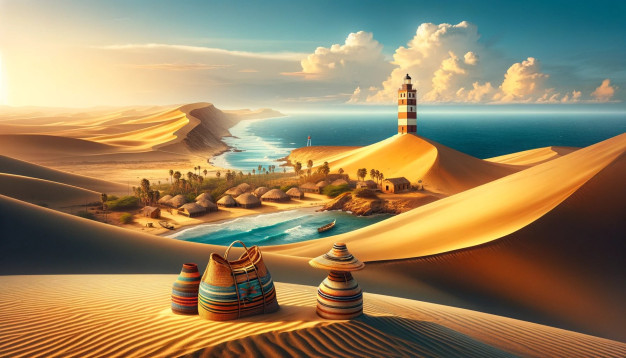Guajira Travel Guide
Explore La Guajira's beauty with tips on essentials, local customs, and must-see spots.

Introduction to La Guajira
La Guajira Desert is a stunning canvas of vibrant blues and burnt oranges, a place where the arid land kisses the Caribbean Sea. This northernmost point of South America is not just a geographical wonder, it’s a cultural treasure trove, home to the resolute Wayuu people who have thrived in these harsh conditions for centuries.
Best Time to Visit
La Guajira’s weather is consistently hot and dry. However, rainy seasons from September to November can turn dirt roads into impromptu rivers. Dry season, particularly between December and April, offers the most accessible conditions for travel.
Transportation to La Guajira
Flights and buses from Bogotá, Medellín, and Santa Marta reach Riohacha, the desert’s gateway. From there, shared jeeps or private vehicles are the norm for the sandy stretch ahead. Remember, this is no place for a low-slung sedan – think sturdy and four-wheel drive.
Must-See Attractions
Cabo de la Vela
An otherworldly landscape with beaches where the desert meets the sea. Sunsets here are not just beautiful; they’re a full-blown celestial spectacle.
Punta Gallinas
The ‘end of the world’ for South America, marked by the continent’s northernmost point. It’s wild, remote, and utterly breathtaking.
El Pilon de Azucar
A sacred hill for the Wayuu, offering panoramic views that justify the sweat to get up there. Spoiler alert: it’s a heart-pumper.
Cultural Experiences
Wayuu indigenous community
Share a smile with the locals and you might just be invited for a chicha. Understanding their culture and traditions is like finding a hidden level in your favorite video game.
Crafts and local markets
Wayuu bags are not just a fashion statement; they’re a story in woven form. Markets also offer a colorful array of hammocks, bracelets, and more.
Cultural etiquette and norms
When visiting, don’t act like a bull in a china shop. Respect local customs, ask before clicking pictures, and remember, haggling is an art form here.
Adventure Activities
- Sandboarding in the dunes is like snowboarding, minus the cold and wetness.
- Kitesurfing in Cabo de la Vela is prime, with consistent winds that could probably send messages to Mars.
- Flamingo Sanctuary exploration is a must-do for birdwatchers and anyone who appreciates the sight of these pink dancers in their natural habitat.
Accommodation and Dining
Accommodations range from basic hammocks under the stars to eco-lodges. As for dining, try the goat meat or lobster if you fancy yourself a bit of a food critic. Not to forget arepas and suero, a local sour cream that’s nothing short of addictive.
Travel Tips and Safety
Pack light-colored, breathable clothing, a sturdy hat, and sunscreen for the unforgiving sun. Hydration is key, so consider a camel pack your new best friend. When exploring, don’t trust paths that seem less traveled – they’re not gems, they’re tricks.
Conclusion
La Guajira is not your average vacation spot; it’s a journey through a land of contrasts and cultures. Visit with respect, tread lightly, and your stories from this desert will be as endless as its horizon.